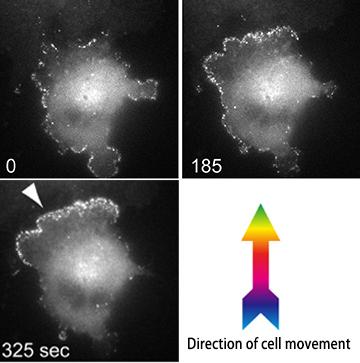Membrane-binding Protein Regulates Cell Motility by Sensing Membrane Tension
By LabMedica International staff writers
Posted on 18 May 2015
A team of Japanese cell biologists has found that the interaction between the degree of plasma membrane tension and a plasma membrane-bending protein regulates cell motility, and that this interaction is disrupted in metastasizing cancer cells.Posted on 18 May 2015
Investigators at Kobe University (Japan) worked with a cultured tumor cell line in studies that succeeding in identifying the link between the membrane-bending protein FBP17 (formin-binding protein-17) and the degree of tension found at a cell's leading edge formation.

Image: FBP17-actin complex-mediated determination of the direction of cell migration. FBP17-actin complexes (white dots) distributed across the cell membrane are recruited over time to the leading edge of migration due to increased tension (Photo courtesy of Biosignal Research Center, Kobe University).
The investigators reported in the May 4, 2015, online edition of the journal Nature Cell Biology that FBP17, an activator of WASP (Wiskott–Aldrich Syndrome protein)/N-WASP-dependent actin nucleation, was a plasma membrane tension sensor involved in leading edge formation. In migrating cells, FBP17 localized to short membrane invaginations at the leading edge, while diminishing from the cell rear in response to plasma membrane tension increase. Conversely, following reduced plasma membrane tension, FBP17 dots randomly distributed throughout the cell, correlating with loss of polarized actin assembly on plasma membrane tension reduction.
In vitro experiments showed that FBP17 membrane-bending activity depended on liposomal membrane tension. Thus, FBP17 was the local activator of actin polymerization that was inhibited by plasma membrane tension in the feedback loop that regulated cell migration. The disruption of cell motility-regulating mechanisms has been cited as a key factor in cancer cell metastasis.
Senior author Dr. Toshiki Itoh, professor of biomedical science at Kobe University, said, "We are promoting research from a less studied perspective to identify new approaches to cancer treatment."
Related Links:
Kobe University










 (3) (1).png)


